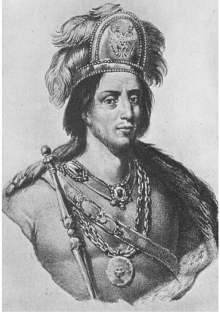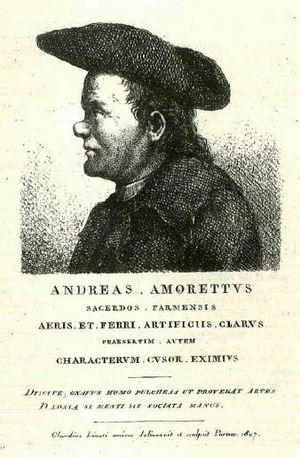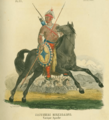Claudio Linati facts for kids
Quick facts for kids
Claudio Linati
|
|
|---|---|
 |
|
| Born | 1 February 1790 Carbonera, Duchy of Parma
|
| Died | 11 December 1832 (aged 42) Tampico, Tamaulipas, Mexico
|
| Nationality | Italian |
| Occupation | Painter, lithographer |
| Known for | Civil, Military and Religious Costumes of Mexico (1828) |
Claudio Linati was an Italian artist born in 1790. He was a painter and a lithographer. Lithography is a special way of printing pictures. Claudio studied art in Paris. He later brought the first lithography machine to Mexico. He also helped start a newspaper called El Iris. This paper was famous for publishing Mexico's first political cartoons!
Linati was very active in politics. He supported revolutionary ideas in Italy, Spain, and Mexico. Because of his strong political views, he had to leave Mexico. He is best known for his beautiful hand-colored book. This book showed the different types of people and their clothes in Mexico.
Contents
Early Life and Art Training
Claudio Linati was born on February 1, 1790. His full name was Marcos Claudio Marcelo Antonio Pompeyo Blas Juan Linati y Prevost. He came from a noble family in Carbonera de Parma, Italy. His father, Filippo Linati, was involved in politics.
Claudio learned from a lawyer named Giuseppe Caderini. When he was 17, he joined the Society of Engravers of Parma. His first known artwork was a portrait of the artist-priest Andrea Amoretti.
In 1809, Linati moved to Paris, France. There, he studied painting with famous artists like Jacques-Louis David. He also learned about lithography, a new printing method at the time.
Linati also became an officer in the army of Napoleon. He was involved in secret groups that wanted to resist unfair rulers. He faced serious charges for his political activities in Italy.
Life in Mexico
Linati arrived in Mexico on March 6, 1825. Mexico had just become independent from Spain. He was asked to explore the coast of Mexico.
In 1826, Linati moved to Mexico City. The Mexican government helped him open a lithography workshop. He and Gaspar Franchini set up the first lithography machine in Mexico in February 1826. Sadly, Franchini passed away during the installation.
Linati also started a school to teach lithography. His students included José Gracida and Ignacio Serrano. The workshop had two printing presses. It also had many French prints for students to learn from. One of Linati's early works in Mexico was a lithograph of a map of Texas.
Linati wanted to observe Mexico as a new independent country. He also wanted to help "civilize" and educate its people about politics.
El Iris Newspaper
Linati became one of the editors of a weekly newspaper called El Iris. It was published from February to August 1826. His partners were Fiorenzo Galli and the poet José María Heredia.
El Iris was a literary newspaper. It featured lithographs of old artifacts and new fashions. It also shared cultural content. The paper included portraits of Mexican independence heroes. These heroes were Guadalupe Victoria, José María Morelos, and Miguel Hidalgo y Costilla.
The newspaper also published strong political opinions. Linati believed Spain would try to conquer Mexico again. He and Galli got involved in arguments between rival groups of Freemasons. Linati supported the idea that people should have power. He believed that a federal system of government would protect individuals and the country. He wanted more education for citizens and good military service.
El Iris published the first political cartoon in Mexico. It was called La Tiranía (Tyranny). Many people believe Linati drew it. The paper demanded freedom of the press across Mexico.
Only 40 issues of El Iris were printed. Its political comments led to the paper being shut down. Linati was forced to leave Mexico in 1826. Even though it was short-lived, El Iris created a lasting example. It showed how journals could use satirical lithographs to comment on politics and society.
Later Years
Linati left Mexico in September 1826. He traveled to New York City and then to Europe. In Brussels, he started working on an illustrated book about Mexico.
His famous book, Civil, Military and Religious Costumes of Mexico, was published in Belgium in 1828. It was also published in London in 1830. This book had text and beautiful illustrations.
Linati continued to be involved in political movements. He was part of groups trying to unite Italy. In 1832, Linati decided to return to Mexico. He arrived in Tampico, Mexico. Sadly, he died three days later on December 11, 1832, from yellow fever.
Claudio Linati is remembered for his strong beliefs in freedom and his artistic contributions. He was a very energetic person. He was interested in the customs of the countries he visited.
Civil, Military and Religious Costumes of Mexico

Linati's 1828 book, Civil, Military and Religious Costumes of Mexico, is very famous. It was the first time a foreigner created a collection of images of Mexican people. It was also one of the first color plate books about Mexico. It had 48 hand-colored lithographs.
The book showed the many different types of people in Mexican society at that time. It set an example for other artists who came after him. The book was later translated into Spanish.
The first picture in the book shows Moctezuma II. He was a symbol of Mexico before Europeans arrived. Linati showed Moctezuma as a strong and respected ruler. Linati believed that human progress and civilization are universal. He compared the cruelty of the Aztec priests to the cruelty of the Roman Catholic Inquisition. He saw both as examples of the problems caused by extreme beliefs.
Linati admired the different cultures in Mexico. However, he also thought that native people should learn Spanish and some new customs. He believed they should learn from the Creole elite and join the army to become full citizens.
The book also showed the wealth of landowners. Linati praised the Creoles for their role in the Mexican revolution. He also highlighted Italian volunteers who helped fight for freedom. These included Count Giuseppe Stavoli and General Vicente Filisola. They are shown in several illustrations.
Linati's book shows many different types of Mexican men and women. The short descriptions with each picture explain the clothes. They also comment on the person shown. For example, Linati joked about a young female worker. He also explained why ancient Mexico did not grow wheat. He noted how surprised a European would be to see a man carrying 50 pounds of water.
One picture shows an Apache chief riding a horse. It highlights his great riding skills. There are also pictures of stylishly dressed Afro-Mexican soldiers and workers. Linati's pictures of Afro-Mexicans were less stereotypical than others at the time.
These pictures give us a valuable look at life in Mexico in the 1820s. However, they are not always perfectly accurate. The colors were added later and can be different in various copies of the book.
Images for kids
See also
 In Spanish: Claudio Linati para niños
In Spanish: Claudio Linati para niños







